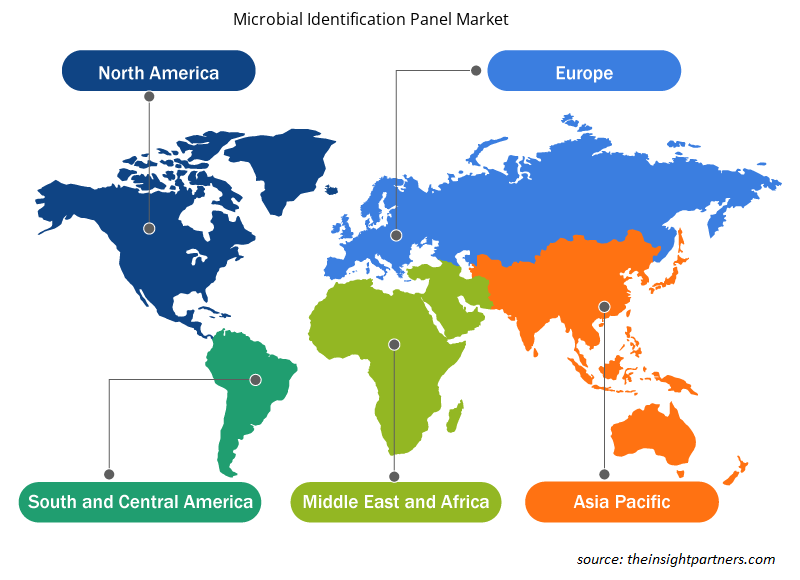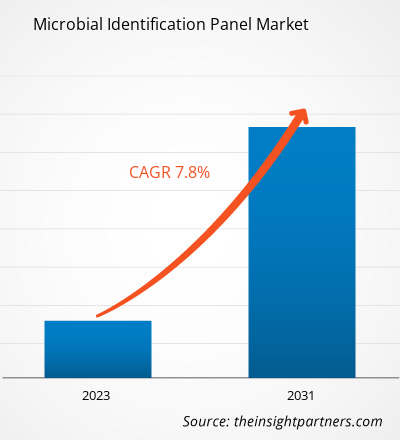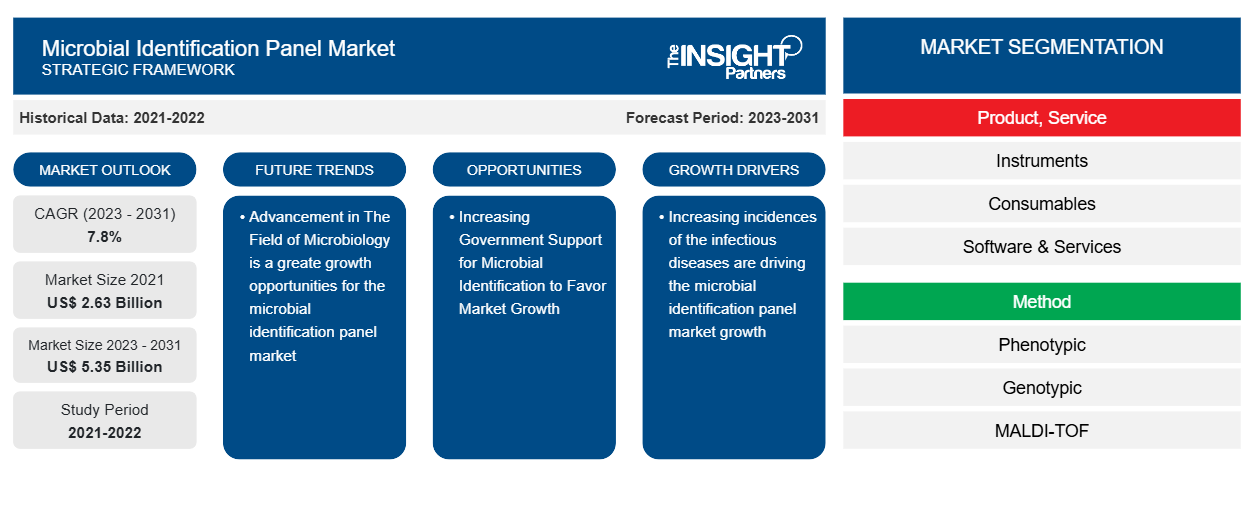Das Marktvolumen für mikrobielle Identifikationspanels wurde auf 2,63 Milliarden US-Dollar im Jahr 2021 und XX Millionen US-Dollar im Jahr 2023 geschätzt und soll bis 2031 5,35 Milliarden US-Dollar erreichen; bis 2031 wird eine durchschnittliche jährliche Wachstumsrate von 7,8 % erwartet. Die Umweltüberwachung in der industriellen Anwendung wird voraussichtlich ein wichtiger Markttrend für mikrobielle Identifikationspanels bleiben.
Marktanalyse für mikrobielle Identifikationspanels
Infektionskrankheiten gehören weltweit zu den Hauptursachen für Morbidität und Mortalität. Die Infektionskrankheiten werden auf verschiedene Weise verbreitet, beispielsweise durch sexuell übertragbare Krankheiten, über Lebensmittel, die Umwelt und andere. Der Hauptgrund für den Anstieg der Fälle von Infektionskrankheiten sind im Gesundheitswesen auftretende Infektionskrankheiten. Infektionserreger wie Parasiten, Pilze, Viren, Bakterien und giftige Produkte verursachen Infektionskrankheiten. Das Humane Immundefizienz-Virus (HIV) ist weltweit ein großes Problem der öffentlichen Gesundheit. Laut dem Gemeinsamen Programm der Vereinten Nationen für HIV/AIDS ( UNAIDS ) lebten im Jahr 2020 etwa 37,7 Millionen Menschen mit HIV. Von diesen Personen waren 36 Millionen Erwachsene und 1,7 Millionen Kinder im Alter von 0 bis 14 Jahren. Darüber hinaus waren mehr als die Hälfte (etwa 53 %) der Infizierten Mädchen und Frauen. Im Jahr 2020 wurden weltweit etwa 1,5 Millionen neue HIV-Fälle gemeldet.
Hepatitis ist eine durch eine Virusinfektion verursachte Entzündung der Leber . Die fünf Hauptstämme der Hepatitisviren sind A, B, C, D und E. Laut der Weltgesundheitsorganisation (WHO) sind weltweit rund 58 Millionen Menschen mit einer chronischen Hepatitis-C-Virusinfektion infiziert, und jedes Jahr treten etwa 1,5 Millionen Neuinfektionen auf. Daher wird erwartet, dass die zunehmende Häufigkeit der Infektion zu einem weltweiten Bedarf an mikrobiellen Identifikationspanels führen wird.
Marktübersicht für mikrobielle Identifikationspanels
Zu den wichtigsten Wachstumsfaktoren für den Markt für mikrobielle Identifikationstafeln zählen Fortschritte auf dem Gebiet der Mikrobiologie, die zunehmende Anwendung von Mikroben in der Industrie, die zunehmende Häufigkeit von Infektionskrankheiten sowie steigende Investitionen von privaten Akteuren und der Regierung. Allerdings dürften hemmende Faktoren wie höhere Kosten für mikrobielle Identifikationsgeräte und Verbrauchsmaterialien das Marktwachstum verlangsamen.
Passen Sie diesen Bericht Ihren Anforderungen an
Sie erhalten kostenlose Anpassungen an jedem Bericht, einschließlich Teilen dieses Berichts oder einer Analyse auf Länderebene, eines Excel-Datenpakets sowie tolle Angebote und Rabatte für Start-ups und Universitäten.
-
Holen Sie sich die wichtigsten Markttrends aus diesem Bericht.Dieses KOSTENLOSE Beispiel umfasst eine Datenanalyse von Markttrends bis hin zu Schätzungen und Prognosen.
Markttreiber und Chancen für mikrobielle Identifikationspanels
Zunehmende staatliche Unterstützung für die mikrobielle Identifizierung soll das Marktwachstum fördern
In Branchen wie der medizinischen Diagnostik, der pharmazeutischen Industrie, der Landwirtschaft, der Lebensmittelindustrie und anderen ist eine mikrobielle Identifizierung erforderlich. In der medizinischen Diagnostik wird beispielsweise eine mikrobielle Identifizierung durchgeführt, um den Erreger zu identifizieren, der bei einem Patienten eine Krankheit verursacht. In ähnlicher Weise hilft die mikrobielle Identifizierung in der Forschung und in der pharmazeutischen Industrie dabei, ein neues Isolat zu identifizieren, das einen wichtigen Prozess durchführt. Daher ist die mikrobielle Identifizierung wichtig, um die Gesundheit zu verbessern und die beste Behandlung anzubieten. Aufgrund der Bedeutung der mikrobiellen Identifizierung im Gesundheitswesen und in anderen Branchen hat die Regierung daher die Unterstützung für die mikrobielle Identifizierung verstärkt. Die Regierungen unterstützen durch die Bereitstellung von Zuschüssen und Mitteln, die Einführung von Initiativen, Anerkennungen und anderen Mitteln. Im Folgenden sind einige Beispiele aufgeführt.
Im Februar 2024 erhielt die Weltgesundheitsorganisation (WHO) von Spendern 4 Millionen US-Dollar zur Einrichtung eines katalytischen Zuschussfonds. Dieser Fonds soll Organisationen unterstützen, die weltweit im Bereich der genomischen Überwachung von Krankheitserregern tätig sind, insbesondere in Ländern mit niedrigem und mittlerem Einkommen. Ziel dieses Fonds ist es, Pilotprojekte durchzuführen und eine Evidenzbasis zu schaffen, die dazu beitragen kann, die genomische Überwachung von Krankheitserregern schnell auszuweiten .
Darüber hinaus können die Mikrobiota oder die Bakterien und Mikroorganismen, die im menschlichen Körper leben, die menschliche Gesundheit und das Krankheitsrisiko beeinflussen. Sie können sogar beeinflussen, wie der Körper Medikamente aufnimmt, obwohl die Details dieser Prozesse noch unklar sind. Im Februar 2024 verlieh das National Institute of General Medical Science der National Institutes of Health einen Maximizing Investigator's Research Award im Wert von 1,9 Millionen US-Dollar an Jordan Bisanz , einen Assistenzprofessor für Biochemie und Molekularbiologie am Penn State Eberly College of Science. Mit dem Preis wird eine fünfjährige Studie finanziert, die die Auswirkungen komplexer mikrobieller Gemeinschaften auf die menschliche Gesundheit untersuchen soll.
Im Juli 2023 erhielt ein multidisziplinäres Forschungsteam unter der Leitung der School of Medicine Infectious Diseases der University of California, Irvine ( UCI ), und darunter Professor Bruce Y. Lee von der CUNY Graduate School of Public Health ( CUNY SPH ), ein Stipendium in Höhe von 13,7 Millionen US-Dollar vom National Institute of Allergy and Infectious Diseases ( NIAID ). Ihre Forschung wird sich auf die Untersuchung der Verbreitung multiresistenter Organismen ( MROs ) in Pflegeheimen in den USA konzentrieren. Aufgrund der zunehmenden staatlichen Unterstützung für die Identifizierung mikrobieller Erreger dürfte der Markt im Prognosezeitraum wachsen.
Fortschritte auf dem Gebiet der Mikrobiologie – eine Chance auf dem Markt für mikrobielle Identifikationspanels
Der technologische Fortschritt schreitet rasant voran. Der steigende Trend macht die klinische und medizinische Diagnostik viel einfacher. Der technologische Fortschritt hat die Zeit für mikrobielle Identifizierungs- und Analyseverfahren verkürzt. Er hat auch dazu beigetragen, Ergebnisse genauer und effizienter zu erzielen. Die Sequenzierungsmethode der nächsten Generation hat es ermöglicht, die genetische Zusammensetzung von Mikroorganismen für verschiedene industrielle Anwendungen zu verstehen.
Darüber hinaus hat der technologische Fortschritt zu einer zunehmenden kommerziellen Nutzung der Mikroorganismen geführt und auch das Feld der Mikrobiologie erweitert. Der Fortschritt hat es ermöglicht, die traditionellen Identifikationskits mit den automatisierten mikrobiellen Identifikationssystemen zu kombinieren. So hat beispielsweise bioMérieux ein API-System und das Biolog Microbial ID-System im 96-Well-Mikroplattenformat entwickelt. Die technologische Entwicklung hat es den Systemen ermöglicht, größere Mengen an Isolaten automatisch zu verarbeiten.
Darüber hinaus hat die Entwicklung der Technologien zur Entwicklung verschiedener Methoden zur mikrobiellen Identifizierung geführt. So wurden beispielsweise Proteinanalysen mittels Matrix-Assisted Laser Desorption Ionization-Time of Flight (MALDI-TOF)-Massenspektrometrie und Gaschromatographieanalysen extrahierter zellulärer Fettsäuren und Fettsäuremethylester (FAMEs) entwickelt. Diese beiden Methoden werden von der Pharmaindustrie häufig zur Herstellung kommerzieller Produkte eingesetzt. Außerdem werden diese Technologien durch ein umfangreiches Profil an Datenbanken und Software unterstützt. Somit bietet die Technologieentwicklung verschiedene Vorteile und ist schneller als kulturbasierte Methoden. Allerdings kann sie vor der Verwendung eine erhebliche Anfangsinvestition und eine umfassende Validierung erfordern.
Daher werden diese Technologien derzeit in Industrieländern eingesetzt, was große Wachstumschancen in Entwicklungsländern verschiedener Industrie- und Entwicklungsregionen schafft. Ein weiteres Beispiel für den technologischen Fortschritt ist die Ribotypisierung, die von Hygiena, LLC als Hygiena RiboPrinter vermarktet wurde. Auf der anderen Seite hat bioMérieux seine PCR-basierten Systeme DiversiLab und it Life Technologies im MicroSEQ Rapid Microbial Identification System eingeführt. Diese Systeme befinden sich jedoch in der Entwicklungsphase und sind in pharmazeutischen Laboren nur begrenzt verfügbar. Einige der spezialisierten Typisierungslabore haben jedoch Zugang zu einer größeren Bandbreite fortschrittlicher Identifizierungsmethoden. Daher ist die Verwendung der Technologien begrenzt, und die Hersteller haben mehr Spielraum, ihr Geschäft in Entwicklungsländern auszuweiten, in denen die Ausgaben für die Gesundheitsbranche höher sind. Aufgrund der oben genannten Faktoren hat der Markt für mikrobielle Identifizierungspanels im Prognosezeitraum daher größere Wachstumschancen.
Marktbericht zu mikrobiellen Identifikationspanels – Segmentierungsanalyse
Wichtige Segmente, die zur Ableitung der Marktanalyse für mikrobielle Identifikationspanels beigetragen haben, sind Produkt und Dienstleistung, Methode und Endbenutzer.
- Basierend auf Produkt und Service ist der Markt für mikrobielle Identifikationspanels in Instrumente, Verbrauchsmaterialien sowie Software und Service unterteilt. Das Segment Instrumente ist weiter unterteilt in automatisierte mikrobielle Identifikationssysteme, Massenspektrometer, PCR und andere Instrumente. Das Segment Verbrauchsmaterialien ist weiter unterteilt in Platten und Medien, Reagenzien und Kits sowie andere Verbrauchsmaterialien. Das Segment Instrumente hatte 2023 den größten Marktanteil.
- Basierend auf der Methode ist der Markt in phänotypisch, genotypisch und MALDI-TOF segmentiert. Das genotypische Segment ist in Sanger-Sequenzierung und Next-Generation-Sequenzierung (NGS) unterteilt. Das Next-Generation-Sequenzierungssegment (NGS) ist weiter unterteilt in 16S/18S/Internal Transcribed Spacer (ITS) rRNA-Sequenzierung, Metagenomik-Sequenzierung, Antibiotikaresistenztests und andere Sequenzierungen. Das phänotypische Segment hatte 2023 den größten Marktanteil.
- In Bezug auf den Endverbraucher ist der Markt in Krankenhäuser und Diagnoselabore, Pharmaunternehmen und andere Endverbraucher segmentiert. Das Segment der anderen Endverbraucher dominierte den Markt im Jahr 2023.
Marktanteilsanalyse für mikrobielle Identifikationspanels nach Geografie
Der geografische Umfang des Marktberichts zu mikrobiellen Identifikationspanelen ist hauptsächlich in fünf Regionen unterteilt: Nordamerika, Asien-Pazifik, Europa, Naher Osten und Afrika sowie Süd- und Mittelamerika.
Der nordamerikanische Markt für mikrobielle Identifikationstafeln wird anhand der drei wichtigsten Länder USA, Kanada und Mexiko analysiert. Die Region hält den größten Marktanteil unter allen anderen Regionen der Welt. Innerhalb der Region tragen die USA am meisten zum Wachstum des Marktes für mikrobielle Identifikationstafeln bei. Das Marktwachstum wird in hohem Maße durch die Weiterentwicklung der Techniken zur mikrobiellen Identifizierung gefördert. Das Land verfügt auch über verschiedene Pharmaunternehmen, akademische und Forschungsinstitute sowie andere Organisationen, die mikrobiologische Verfahren durchführen.
Es wird außerdem erwartet, dass der Markt aufgrund des wachsenden Pharmasektors und der wachsenden Forschung und Entwicklung in Kanada wachsen wird. Das Land erlebt auch ein enormes Wachstum im Pharma- und anderen Gesundheitssektor, der ebenfalls einen großen Beitrag zum Wachstum des Marktes für mikrobielle Identifikationspanels leistet. In Mexiko hingegen dürfte der Markt aufgrund der zunehmenden Entwicklungen im Gesundheitssektor mehrere Wachstumschancen bieten.
Regionale Einblicke in den Markt für mikrobielle Identifikationspanels
Die regionalen Trends und Faktoren, die den Markt für mikrobielle Identifikationspanels während des gesamten Prognosezeitraums beeinflussen, wurden von den Analysten von Insight Partners ausführlich erläutert. In diesem Abschnitt werden auch die Marktsegmente und die Geografie für mikrobielle Identifikationspanels in Nordamerika, Europa, im asiatisch-pazifischen Raum, im Nahen Osten und Afrika sowie in Süd- und Mittelamerika erörtert.

- Erhalten Sie regionale Daten zum Markt für mikrobielle Identifikationspanels
Umfang des Marktberichts zu mikrobiellen Identifikationspanelen
| Berichtsattribut | Details |
|---|---|
| Marktgröße im Jahr 2021 | 2,63 Milliarden US-Dollar |
| Marktgröße bis 2031 | 5,35 Milliarden US-Dollar |
| Globale CAGR (2023 - 2031) | 7,8 % |
| Historische Daten | 2021-2022 |
| Prognosezeitraum | 2023–2031 |
| Abgedeckte Segmente |
Nach Produkt, Service
|
| Abgedeckte Regionen und Länder |
Nordamerika
|
| Marktführer und wichtige Unternehmensprofile |
|
Marktteilnehmerdichte: Der Einfluss auf die Geschäftsdynamik
Der Markt für mikrobielle Identifikationspanels wächst rasant, angetrieben durch die steigende Nachfrage der Endnutzer aufgrund von Faktoren wie sich entwickelnden Verbraucherpräferenzen, technologischen Fortschritten und einem größeren Bewusstsein für die Vorteile des Produkts. Mit steigender Nachfrage erweitern Unternehmen ihr Angebot, entwickeln Innovationen, um die Bedürfnisse der Verbraucher zu erfüllen, und nutzen neue Trends, was das Marktwachstum weiter ankurbelt.
Die Marktteilnehmerdichte bezieht sich auf die Verteilung der Firmen oder Unternehmen, die in einem bestimmten Markt oder einer bestimmten Branche tätig sind. Sie gibt an, wie viele Wettbewerber (Marktteilnehmer) in einem bestimmten Marktraum im Verhältnis zu seiner Größe oder seinem gesamten Marktwert präsent sind.
Die wichtigsten auf dem Markt für mikrobielle Identifikationspanels tätigen Unternehmen sind:
- Becton, Dickinson und Company
- Thermo Fisher Scientific Inc.
- Danaher Corporation
- bioMérieux
- Merck KgaA
- Charles River Laboratories, Inc.
Haftungsausschluss : Die oben aufgeführten Unternehmen sind nicht in einer bestimmten Reihenfolge aufgeführt.

- Überblick über die wichtigsten Akteure auf dem Markt für mikrobielle Identifikationspanels
Neuigkeiten und aktuelle Entwicklungen zum Markt für mikrobielle Identifikationspanels
Der Markt für mikrobielle Identifikationspanels wird durch die Erfassung qualitativer und quantitativer Daten nach Primär- und Sekundärforschung bewertet, die wichtige Unternehmensveröffentlichungen, Verbandsdaten und Datenbanken umfasst. Im Folgenden finden Sie eine Liste der Entwicklungen auf dem Markt für Innovationen, Geschäftserweiterungen und Strategien:
- Im Januar 2023 erwarb Biolog Inc. MIDI Labs und MIDI, Inc., beide mit Hauptsitz in Newark, Delaware. Biolog und MIDI bedienen viele derselben Kunden und Branchen. In den letzten zwei Jahrzehnten haben beide Unternehmen die mikrobielle ID-Community mit ergänzenden Produkten und Dienstleistungen bedient. MIDI Labs ist ein Innovator in der mikrobiellen Identifizierung, der derzeit Vertragslabordienstleistungen für die mikrobielle Identifizierung und Zählung anbietet, um kritische, zeitkritische IDs für die Herstellung von Arzneimitteln, Probiotika, Lebensmitteln und Getränken sowie Körperpflegemitteln mithilfe von Sequenzierung und MALDI-TOF-Massenspektrometrie bereitzustellen. (Quelle: Biolog Inc, Pressemitteilung, 2023)
- Im April 2023 brachte Bruker Corporation die schnelle MALDI Biotyper IVD-Software der nächsten Generation sowie das optimierte MBT Mycobacteria IVD Kit und das MBT HT Filamentous Fungi IVD-Modul auf den Markt. Die Markteinführung soll die benutzerfreundlichen, erstklassigen Diagnoselösungen des Unternehmens für Routinelabore der klinischen Mikrobiologie und Infektionsdiagnostik ergänzen. (Quelle: Bruker Corporation, Newsletter, 2023)
Marktbericht zu mikrobiellen Identifikationspanels – Umfang und Ergebnisse
Der Bericht „Marktgröße und Prognose für mikrobielle Identifikationspanels (2021–2031)“ bietet eine detaillierte Analyse des Marktes, die die folgenden Bereiche abdeckt:
Marktgröße und Prognose für mikrobielle Identifikationspanels auf globaler, regionaler und Länderebene für alle wichtigen Marktsegmente, die im Rahmen des Berichts abgedeckt sind
- Marktdynamik wie Treiber, Beschränkungen und wichtige Chancen
Markttrends für mikrobielle Identifikationspanels
- Detaillierte PEST/Porters Five Forces- und SWOT-Analyse
Marktanalyse für mikrobielle Identifikationspanels mit wichtigen Markttrends, globalen und regionalen Rahmenbedingungen, wichtigen Akteuren, Vorschriften und jüngsten Marktentwicklungen
Markt für mikrobielle Identifikationspanels – Branchenlandschaft und Wettbewerbsanalyse, einschließlich Marktkonzentration, Heatmap-Analyse, prominenten Akteuren und jüngsten Entwicklungen
- Detaillierte Firmenprofile
- Historische Analyse (2 Jahre), Basisjahr, Prognose (7 Jahre) mit CAGR
- PEST- und SWOT-Analyse
- Marktgröße Wert/Volumen – Global, Regional, Land
- Branchen- und Wettbewerbslandschaft
- Excel-Datensatz
Aktuelle Berichte
Erfahrungsberichte
Grund zum Kauf
- Fundierte Entscheidungsfindung
- Marktdynamik verstehen
- Wettbewerbsanalyse
- Kundeneinblicke
- Marktprognosen
- Risikominimierung
- Strategische Planung
- Investitionsbegründung
- Identifizierung neuer Märkte
- Verbesserung von Marketingstrategien
- Steigerung der Betriebseffizienz
- Anpassung an regulatorische Trends























 Kostenlose Probe anfordern für - Markt für mikrobielle Identifizierungspanels
Kostenlose Probe anfordern für - Markt für mikrobielle Identifizierungspanels